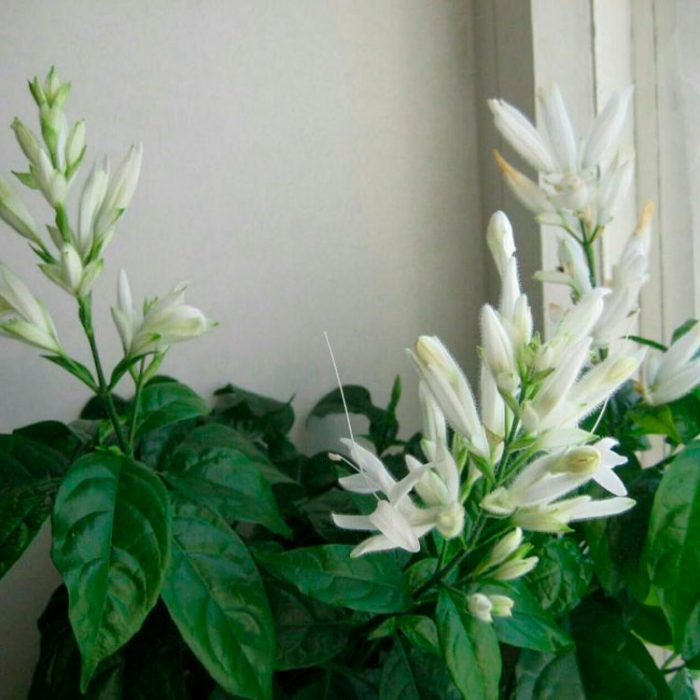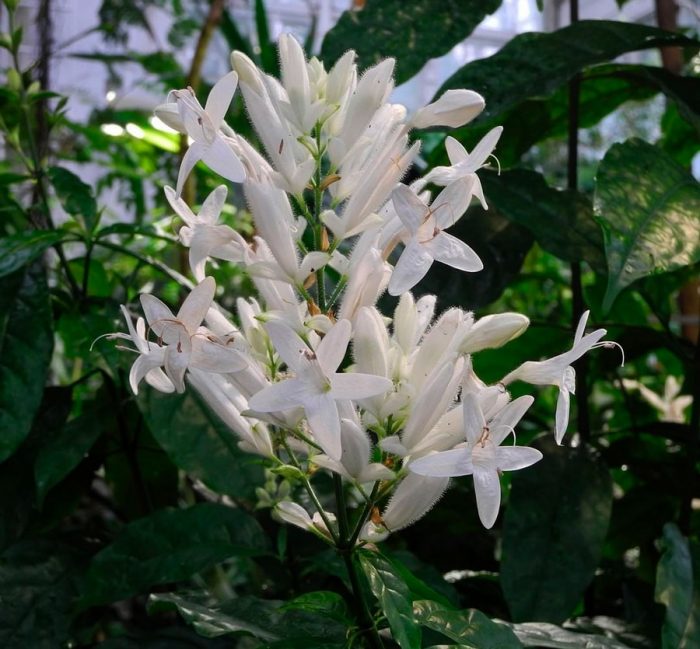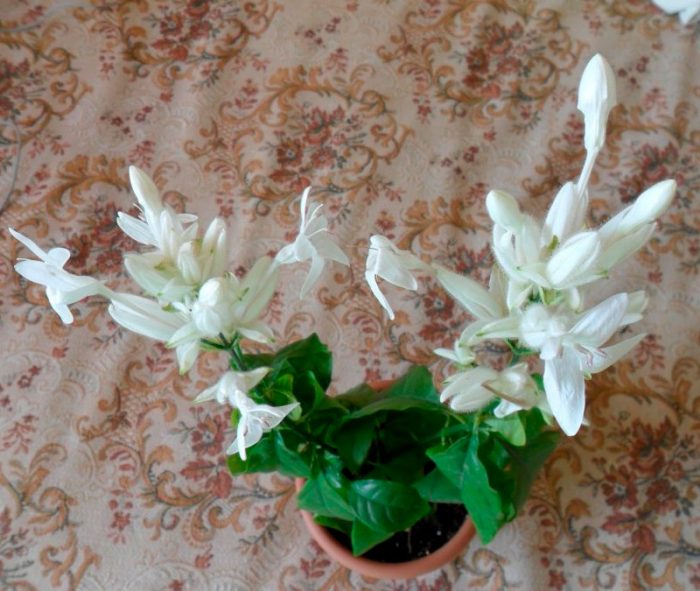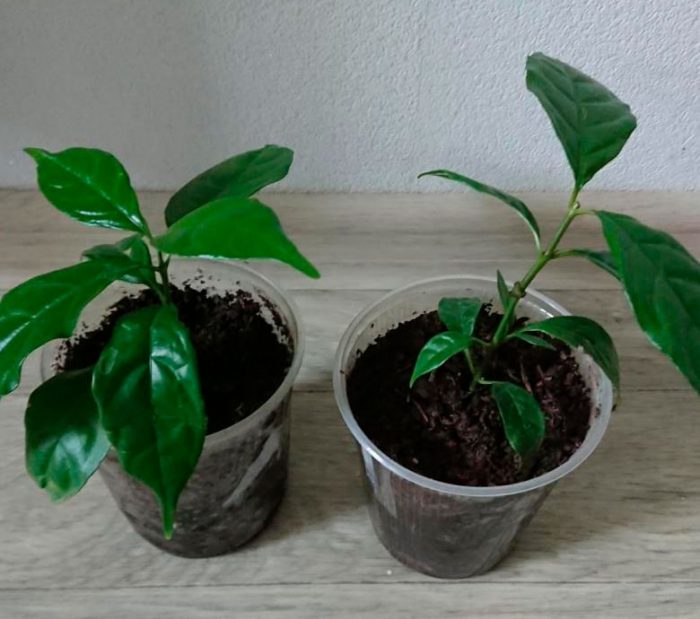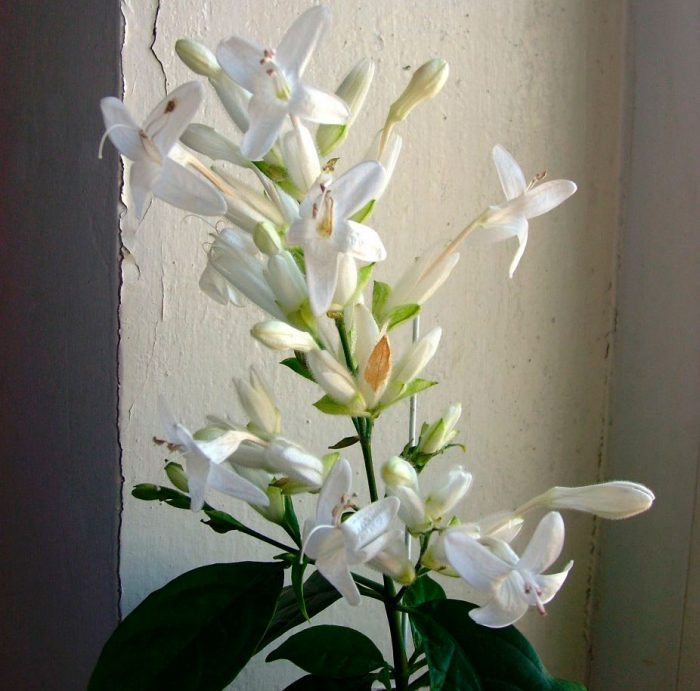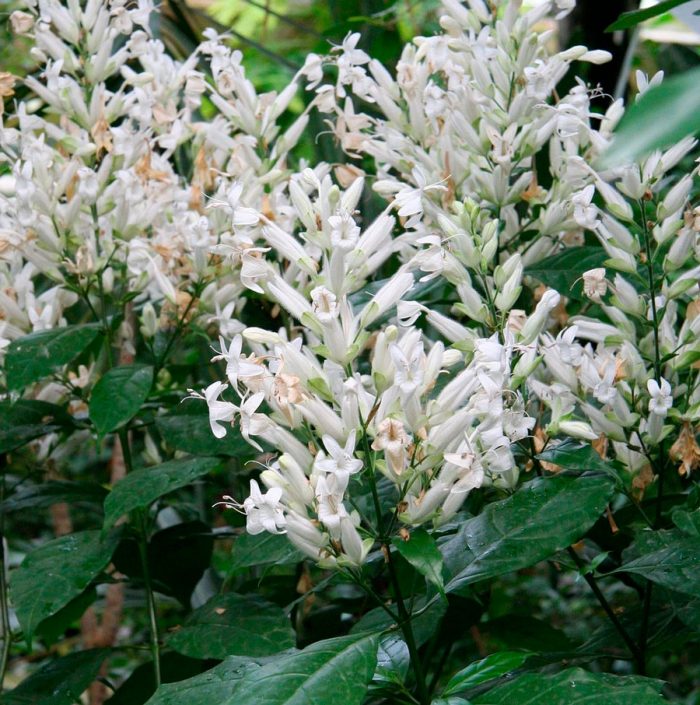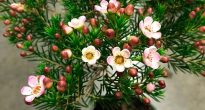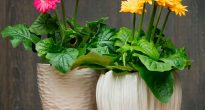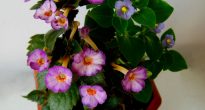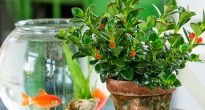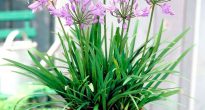The beautifully flowering plant Whitfieldia is part of the Acanthus family. In nature, this plant has a height of about 100 cm.At home, pruning is regularly carried out, which limits the growth of the flower, as a result of which its height, as a rule, does not exceed 0.6 m.
On average, the plant grows in height from 10 to 15 centimeters per year. Whitefeldia blooms for quite a long time: from the last days of October to early spring. During this period, beautiful spike-shaped inflorescences are formed on the bush, which consist of white flowers. That is why such a flower is popularly called "White Candles". He comes from tropical Africa.
Whitefeldia has an average growth rate, and is also a perennial. It is unpretentious in care, therefore it is suitable even for beginners in floriculture.
Content
Brief description of cultivation
- Temperature... In summer, no more than 30 degrees, and in winter - from 15 to 18 degrees.
- Air humidity... Should be elevated. The flower is moistened every day from a spray bottle.
- Illumination... Large amount of bright diffused light. Protect from direct sunlight.
- Watering... In summer, the substrate is moistened abundantly, and in the winter months - moderately.
- Soil mixture... Nutritious, lightweight and moisture-absorbing.
- Top dressing... Twice a month with a universal mineral complex for indoor plants.
- Transfer... Systematically once a year in spring.
- Reproduction... Cuttings and seed method.
- Pruning... Formative pruning should be done regularly.
Whitefeldia home care
In order for indoor whitefeldia to develop correctly and bloom magnificently every year, you need to know several rules for caring for it.
Bloom
Whitefeldia, growing at home, blooms in the second half of autumn, and fades only in spring. Her flowers are relatively large and are part of dense spike-shaped inflorescences. They have fluffy bracts and curved long stamens, painted in a yellow tint. In indoor culture, this plant does not form seeds.
Temperature
In the warm season, the plant is not afraid of heat, it can withstand temperatures up to 30 degrees quite calmly. Wintering should be cool at temperatures between 15 and 18 degrees.If it is warm in winter, then because of this, the stems can become very elongated.
Air humidity
Since whitefeldia is a tropical plant, it needs high humidity. That is why the bush must be moistened every day from a sprayer with soft water, the temperature of which is close to room temperature. Also, to increase the humidity, it is recommended to pour wet expanded clay into the pallet, and put a pot with a plant on top of it.
Illumination
Homemade whitefeldia needs a lot of bright, diffused light. Therefore, she will feel great on the western or eastern windowsill. In summer, if possible, the bush is transferred to the garden, where they choose a place for it in shade.
Watering
During warmer months, watering should be frequent and abundant (three or four times a week). With a cool winter, the abundance and frequency of watering are slightly reduced. Make sure that the potting soil is always slightly damp. Remember that whitefeldia reacts equally negatively both to stagnant liquid in the substrate and to dry earth coma.
Pot selection
The root system of such a tropical flower is powerful, while it grows and develops very quickly. In this regard, for its cultivation, you should choose a fairly spacious pot, which can be made of ceramics or strong plastic. Please note that there must be drainage holes at the bottom.
Soil mixture
The substrate should be fertile and loose. For example, in a specialized store, you can purchase a universal dredge. If desired, the substrate can be prepared with your own hands; for this, combine peat, sand, sod soil and humus, which are taken in equal shares.
Top dressing
In order for the bush to delight you with lush regular flowering, it should be fed twice a month. For this, a universal complex mineral fertilizer for indoor plants is suitable. Whitefeldia also responds well to feeding with organic fertilizers.
Transfer
The flower is transplanted in the spring. Gently remove the bush from the container and trim some of its roots. The growth of young roots activates the more rapid development of the aerial part of the plant.
Pruning
In order for the flower to always look spectacular and neat, it should be provided with systematic pruning. In springtime, all the stems of the bush should be shortened by about 1/3 part. It is recommended to feed the pruned bush with a fertilizer containing nitrogen so that it can quickly recover.
Dormant period
The dormant period of this plant is not pronounced. Flowering and active growth continues in winter. To prevent the stems from stretching due to poor lighting in winter, the bush will need backlighting.
Reproduction methods
Growing from seeds
Homemade whitefeldia does not set seeds. They are not sold in specialized stores. The only option is that seed can be bought from collectors, but it will be quite expensive. In this regard, flower growers propagate whitefeldia by seeds in very rare cases.
Cuttings
Most often, such a plant in room culture is propagated by stem cuttings, especially since this is quite simple to do. For harvesting cuttings, non-lignified and not diseased stems are chosen. In length, they should reach from 50 to 80 millimeters. For rooting, they are planted in a substrate consisting of peat and sand. In order for the roots to appear on the cuttings as quickly as possible, the temperature in the room is maintained at least 24 degrees. After the cuttings are completely rooted, they are planted in separate pots.
Possible problems
If the rules for caring for whitefeldia are violated or under inappropriate growing conditions, problems may arise with it:
- Faded foliage... This means that the flower lacks light. To remedy the situation, transfer the pot with the plant to a well-lit windowsill or provide it with additional lighting.
- The stems became very elongated... This is due to excessively poor lighting or the fact that the bush is warm during the wintering period.
- Drying of the tips of the leaf plates... This often happens when the air in the room is too dry. Because of this, the flower will not die, but its decorative effect will be greatly affected. To avoid this, it must be moistened every day from a spray bottle with cold water.
- The sheet plates are rolled up... This problem arises if the bush is on a brightly lit windowsill and the air in the room is too dry.
- Brown dry spots of various sizes are formed on the leaf plates.... These are sunburns that form due to direct sunlight hitting the leaves.
- Yellowing and death of lower foliage... This is the fault of the regular stagnation of moisture in the substrate. To save whitefeldia, it must be urgently transplanted into a new and dry substrate, and do not forget about a good drainage layer.
Pests such as aphids, mealybugs and spider mites can settle on the bush.
Whitefeldia species
At home, only 2 species of whitefeldia are cultivated, which will be described below.
Whitefeldia brick red (Whitfieldia lateritia)
The homeland of such a compact plant is Sierra Leone. The stems are decorated with glossy oval leaf plates with a pointed apex. The inflorescences are bright brick-red flowers.
Whitefeldia long-leaved (Whitfieldia elongata)
In nature, this species can be found in Angola, Cameroon and Congo. Its flowers are snow-white, and the foliage is glossy and opposite.

